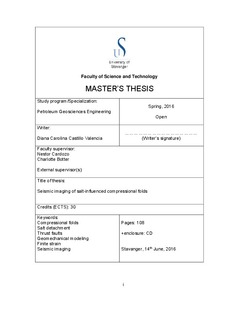| dc.description.abstract | Fold-and-thrust belts (FTB) detaching on salt have a high potential for developing trap structures and host large oil and gas fields. Due to their high structural complexity and often low-quality seismic data, their understanding is limited. Furthermore, the presence of salt adds challenges for seismic imaging because of strong acoustic impedance at the salt boundaries. Hence, seismic characterization of these structures has high uncertainty, giving room to different interpretations. The main objective of this study is to present a methodology to forward model seismic images of compressional folds influenced by a salt layer, and in addition syn-sedimentation, in order to study the evolution of these structures and evaluate acquisition and processing parameters for better seismic imaging and interpretation. The methodology consists of a geomechanical modeling of the FTB using a 2D discrete element method (DEM), finite strain computation in the DEM, update of the base seismic properties of the DEM based on finite strain, and seismic imaging of the DEM using a ray-based pre-stack depth migration (PSDM) algorithm. This workflow is illustrated for a 2D DEM model consisting of a brittle siliciclastic – ductile salt sequence under imposed lateral shortening, which initiates and propagates thrust faulting through the siliciclastic sequence. To investigate the influence of salt and syn-sedimentation, three models are considered: Model 1 with no salt, Model 2 with salt, and Model 3 including salt, and syn-sedimentation. All simulations produce realistic although different FTB geometries. Seismic images are modeling for the pre-growth/growth interlayered sequence of sandstone and shale for four different wave frequencies from 10 to 40 Hz, and three different illumination directions (specular, right and left side). At 30 Hz and side illumination, the complexity of the larger thrust faults and the geometry and internal organization of syn-sedimentation can be better represented than at the lower 10 Hz frequency images. As a result, by combining several acquisition and processing parameters (illumination direction and wave frequency), it is possible to improve seismic imaging of salt-influenced compressional folds. | nb_NO |
